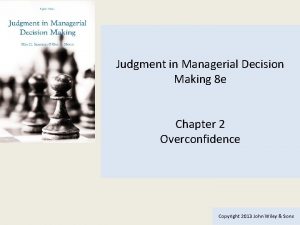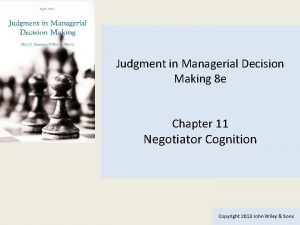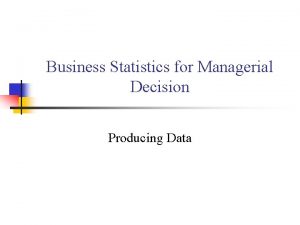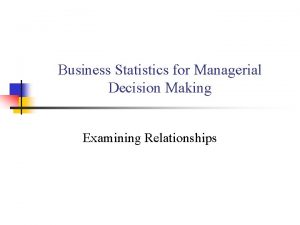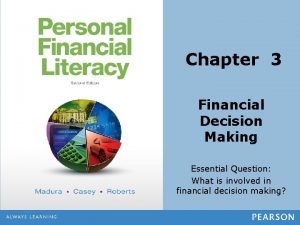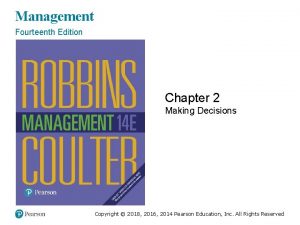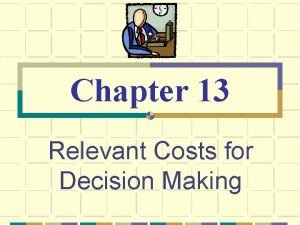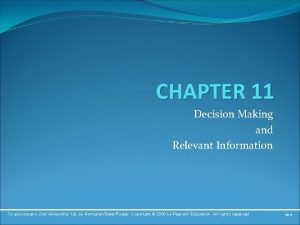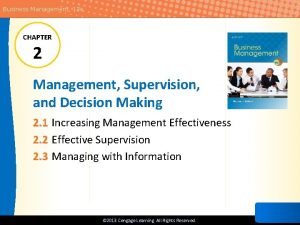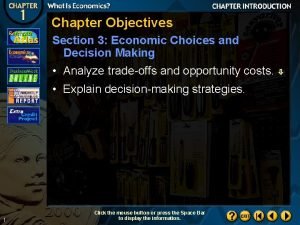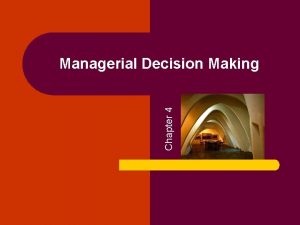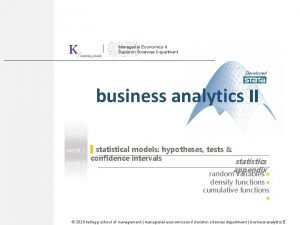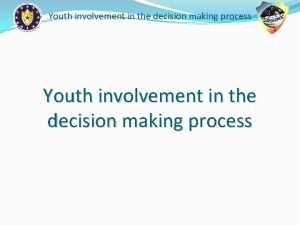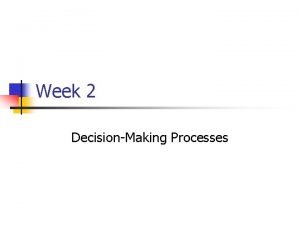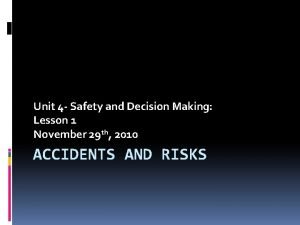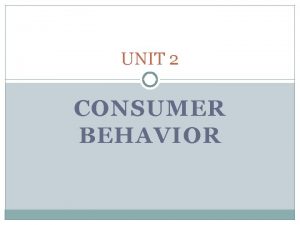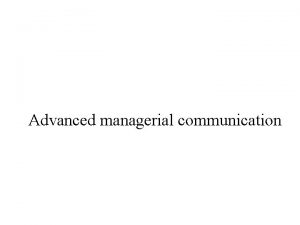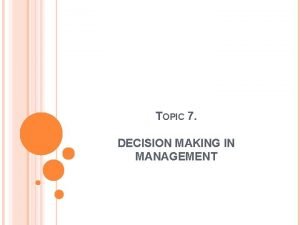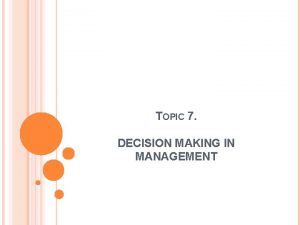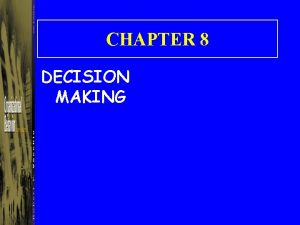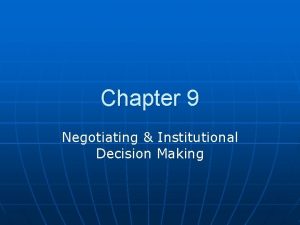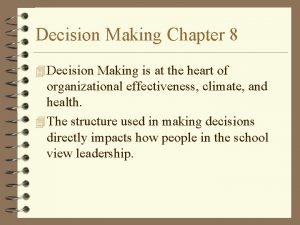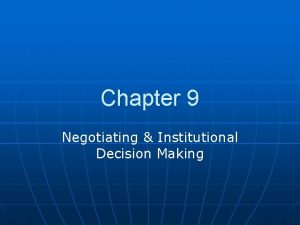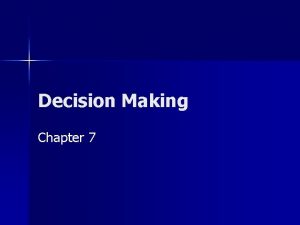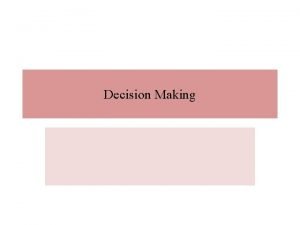Chapter 4 Managerial Decision Making Managerial Decision Making

































- Slides: 33

Chapter 4 Managerial Decision Making

Managerial Decision Making l Decision making is not easy l It must be done amid – – – 2 ever-changing factors unclear information conflicting points of view

Definition : Decision Making 3 l The process of identifying and selecting a course of action to solve a specific problem l Decision is a choice between two or more alternatives l Decision is on the basis of conscious logic l Decision must bring the organization closer to the goal

Components of Decision Making Objective or Problem Alternatives Choice 4

Characteristics of Decision making l l l l Existence of alternatives Negative or positive Freedom of choice Result oriented Intellectual process Logical process Continuous process Situational

Importance of decision making l l l l Leads to optimum utilization of resources Core of Planning Helps to attain objectives Improves efficiency Means to problem solving Helps to face challenges Leads to motivated and dedicated employees

Six Steps in the Managerial Decision-Making Process Evaluation and Feedback Implementation of Chosen Alternative Decision. Making Process Selection of Desired Alternative 7 Defining and analyzing the problem Generating Alternative Solutions Evaluating Alternatives

Types of Managerial decisions l l l 8 Programmed and Non programmed Personal and Organizational Individual and Group Routine and Strategic Policy and Operating

Categories of Decision Making Techniques l Programmed Decision Making – – l Non-programmed Decision Making – 9 Situations occurred often enough to enable decision rules to be developed and applied in the future Made in response to recurring organizational problems in response to unique, poorly defined and largely unstructured situations, and have important consequences to the organization

Programmed Decision Making Techniques

Linear Programming l l a quantitative technique used to decide how to distribute the limited resources for achieving the objectives linear means the relationship between variables is staight, and programming means taking decisions systematically used when two or more activities are competing for limited resources

Example of Linear Programming l l You need to buy some filing cabinets. You know that Cabinet X costs $10 per unit, requires six square feet of floor space, and holds eight cubic feet of files. Cabinet Y costs $20 per unit, requires eight square feet of floor space, and holds twelve cubic feet of files. You have been given $140 for this purchase, though you don't have to spend that much. The office has room for no more than 72 square feet of cabinets. How many of which model should you buy, in order to maximize storage volume? x: number of model X cabinets purchased y: number of model Y cabinets purchased Naturally, x > 0 and y > 0 cost: 10 x + 20 y < 140 space: 6 x + 8 y < 72 volume: V = 8 x + 12 y

Game Theory l l A game is a situation involving at least two people Each person’s decision is based on what he expects the other to do Used for deciding about competitive pricing Both decision- makers adapt to each other's decisions

Payoff Matrix l l l A statistical technique, which helps managers to choose the best alternative. Payoff is the return or reward for selecting the best alternative Best alternative can be a combination of many alternatives or a single alternative

Game Theory -example l A river flows through two countries, A and B. It starts in country A, and then flows through B to the ocean. Both countries can either dam the river (and get electricity) or fish the river. If either country dams the river, it hurts the fish population in the river (either by decreasing the water flow downstream, or preventing fish from swimming upstream). So if one dams and the other fishes, it's bad for the one who fishes. If they both fish, it's good for both, but not as good as if they both dam, since the electric power is worth more than the fish.

Game theory –Payoff matrix B fishes B dams A Dams A fishes +2, +2 0, +2 +2, 0 +1, +1

Simulation l l l used to decide about complex problems effect of the decision is observed in a simulated situation and not in a real situation find out the effectiveness of its new advertisement by first showing it to few people before telecasting it on TV

Queuing Theory l l used to find solutions to the waiting list problems in case of airline reservations, railway reservations, college admissions, etc helps to find out the optimum number of service facilities required and the cost of these services

Network Techniques l l l Network techniques like PERT (Program Evaluation Review Technique) and CPM (Critical Path Method) are used for complex projects, where many activities have to be completed In CPM, the critical activities of a program or a project are identified. These are the activities that have a direct impact on the completion date of the project. PERT is a method to analyze the involved tasks in completing a given project, especially the time needed to complete each task, and to identify the minimum time needed to complete the total project.

CPM and PERT l l In the critical path method, the critical activities of a program or a project are identified. These are the activities that have a direct impact on the completion date of the project. PERT is a method to analyze the involved tasks in completing a given project, especially the time needed to complete each task, and to identify the minimum time needed to complete the total project.

CPM-Website Design Process

PERT

Probability Decision Theory l l Based on the assumption that the future is uncertain There is a chance that a certain event may or may not take place Based on available data and subjective judgment of the manager, various probabilities are assigned (given) to alternative courses of action (decision) The likely / possible outcomes of different alternatives are evaluated, and the most likely alternative is selected

Decision Tree l l l a diagram which shows all the possible alternatives of a decision information can be seen at one glance like a horizontal tree base of the tree is called the Decision Point from this point, the different alternatives and subalternatives are shown as branches and subbranches study all the alternatives very carefully and select the best alternative

Decision tree

Non Programmed Decision Making Techniques Brainstorming Nominal Group Technique Delphi Technique Quality Circles Heuristic Technique Participative Technique

Brainstorming l l l l Developed by Osborn, who is called ‘The Father of Brainstorming’ To improve problem solving by finding new or creative solutions Five to ten persons Leader of the group tells them the problem All possible ideas are invited to solve the problem All the ideas are discussed analysed The best idea is selected

Delphi technique l l Similar to brainstorming technique, except that the group members do not meet face to face Group members are located at different places Questionnaires are used to collect information from the group members Group members are not influenced by one another, since they do not meet fact to face

Nominal Group Technique l l Group members think independently Each person comes up with his own ideas No interaction among the group members at the early stage Interaction takes place only after the ideas are presented by every single member of the group

Quality Circles l l started in Japan in the early 1960 s Is a small group of employees from the same department who volunteer to meet regularly in order to identify, analyze and to solve problems about their work

Heuristic Technique l decisions are made based on experience, rule of thumb, common sense, etc

Participative Technique l l l Employees also involved in decision making process Promotes accountability and commitment Increases employee motivation

Thank You
 Judgment in managerial decision making 8th edition
Judgment in managerial decision making 8th edition Mythical fixed pie assumption
Mythical fixed pie assumption Managerial versus entrepreneurial decision making
Managerial versus entrepreneurial decision making Statistics for managerial decision making
Statistics for managerial decision making Statistics for managerial decision making
Statistics for managerial decision making No decision snap decision responsible decision
No decision snap decision responsible decision Financial decision
Financial decision Chapter 6 prices and decision making assessment answers
Chapter 6 prices and decision making assessment answers Five step decision making process
Five step decision making process Chapter 2 economic systems and decision making
Chapter 2 economic systems and decision making Management chapter 5 planning and decision making
Management chapter 5 planning and decision making Financial decision-making process
Financial decision-making process Chapter 2 economic systems and decision making
Chapter 2 economic systems and decision making Copyright
Copyright Relevant cost for decision making solution chapter 13
Relevant cost for decision making solution chapter 13 Chapter 2 economic systems and decision making answer key
Chapter 2 economic systems and decision making answer key Chapter 11 decision making and relevant information
Chapter 11 decision making and relevant information Chapter 2 management supervision and decision making
Chapter 2 management supervision and decision making Relevant information for decision making
Relevant information for decision making Management chapter 5 planning and decision making
Management chapter 5 planning and decision making Chapter 1 section 3 economic choices and decision making
Chapter 1 section 3 economic choices and decision making Managerial decision problems
Managerial decision problems Managerial economics and decision sciences
Managerial economics and decision sciences Decision tree and decision table examples
Decision tree and decision table examples Youth involvement
Youth involvement Nasw code of ethics
Nasw code of ethics Systematic decision making process
Systematic decision making process Paced decision making
Paced decision making Mamdm
Mamdm Using recursion in models and decision making sheet 3
Using recursion in models and decision making sheet 3 Paced decision making
Paced decision making Unit 4 lesson 1 decision making
Unit 4 lesson 1 decision making Decision making unit example
Decision making unit example Types of decision making
Types of decision making
